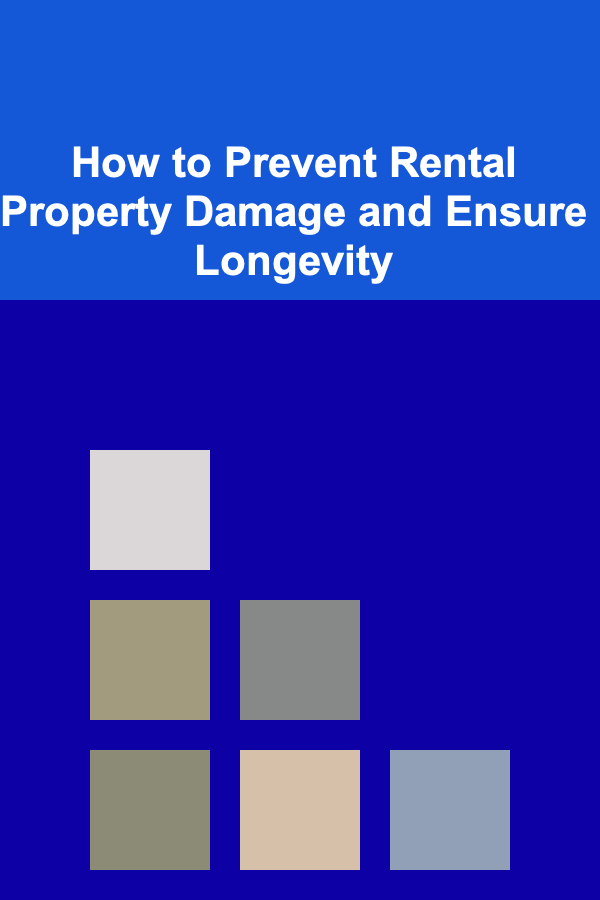
How to Prevent Rental Property Damage and Ensure Longevity
ebook include PDF & Audio bundle (Micro Guide)
$12.99$6.99
Limited Time Offer! Order within the next:

Owning rental property is a lucrative investment, but it comes with significant responsibilities, including maintaining the condition of the property and ensuring its longevity. The longer your rental property remains in good condition, the less you'll have to spend on repairs and the higher your return on investment will be. Preventing damage and promoting longevity doesn't just mean fixing things when they break; it involves proactive maintenance, understanding tenant behaviors, addressing wear and tear, and planning for the future.
In this article, we will explore various ways to prevent rental property damage and ensure its longevity. We will discuss maintenance strategies, tenant communication, effective property management practices, and how to budget for long-term property upkeep. By taking the necessary precautions and adopting a proactive mindset, landlords can protect their investments and keep properties in excellent condition for years to come.
Understanding Common Causes of Rental Property Damage
Before diving into solutions, it's important to understand the most common causes of rental property damage. By identifying these factors, landlords can develop strategies to minimize the risks of costly repairs and damage.
1.1 Tenant Negligence and Poor Habits
One of the primary causes of property damage in rental homes is tenant negligence. Tenants may fail to follow basic maintenance protocols, ignore minor issues, or create wear and tear through poor habits. Some common examples include:
- Clogging sinks and drains: Improper disposal of grease, food scraps, and hygiene products can lead to plumbing issues.
- Not reporting maintenance issues promptly: Tenants who don't report minor issues like a leaky faucet or a broken window may allow these problems to escalate into expensive repairs.
- Failure to clean properly: Neglecting to clean appliances, such as the oven or refrigerator, or leaving areas like bathrooms and kitchens dirty can cause mold, grime buildup, and the need for more frequent cleaning or repairs.
1.2 Environmental Factors
Another major contributor to property damage is environmental wear and tear. Weather conditions, such as heavy rainfall, extreme temperatures, and humidity, can all cause significant damage over time. For instance:
- Water damage: Leaks, flooded basements, or a malfunctioning roof can result in significant water damage, mold growth, and structural degradation.
- Temperature extremes: Freezing temperatures in the winter can cause pipes to burst, while hot summers can strain air conditioning units or cause wear to exterior paint.
- Humidity: Areas with high humidity levels can cause moisture problems, especially if there's insufficient ventilation. This can lead to mold, mildew, or rotting wood.
1.3 Structural Issues and Age of Property
As a property ages, the materials used in its construction naturally begin to deteriorate. This includes everything from the roof to plumbing and electrical systems. Older properties are particularly vulnerable to:
- Foundation issues: Cracks in the foundation can lead to further structural instability and may eventually lead to major repairs.
- Roof deterioration: Shingles, tiles, and roofing materials wear down over time, which can result in leaks and water damage if not addressed.
- Outdated electrical systems: Old wiring may be unable to handle modern electrical demands, posing both a safety risk and potential for costly repairs.
1.4 Pets and Children
Tenants with pets or young children often lead to more wear and tear. Pets can scratch floors, chew on furniture, or leave stains, while children can cause scuff marks on walls, break fixtures, or cause other accidental damage.
Preventive Maintenance Practices
Preventive maintenance is one of the most effective ways to extend the life of a rental property and reduce the likelihood of expensive repairs. By staying on top of regular maintenance tasks and ensuring that all systems are functioning as they should, landlords can keep their properties in prime condition.
2.1 Regular Inspections
One of the best ways to prevent damage is to conduct regular property inspections. These inspections help identify small issues before they turn into large, costly problems. Depending on the property type and lease agreement, it's a good idea to conduct inspections every six months to a year.
During an inspection, check for:
- Signs of water damage: Look for leaks, moisture, or mold in areas like the roof, basement, kitchen, and bathroom.
- Plumbing issues: Examine sinks, pipes, toilets, and showers for leaks or slow drainage. Ensure water pressure is consistent.
- Electrical systems: Check outlets, light fixtures, and electrical panels for damage or wear.
- Structural integrity: Inspect the foundation, walls, and ceilings for cracks, bulges, or other signs of damage.
By identifying issues early, you can either fix them before they get worse or inform the tenants so they can avoid worsening the problem.
2.2 Seasonal Maintenance
Seasonal maintenance helps ensure that your property is prepared for the challenges each season presents. Different weather conditions pose various risks, and addressing them before they occur can save you from costly repairs.
- Winter preparation: In colder climates, it's essential to winterize the property. This includes cleaning out gutters, insulating pipes to prevent freezing, and checking heating systems. Be sure to address any leaks or drafts in windows and doors to keep heating bills low and prevent cold damage.
- Spring and summer: During the warmer months, focus on air conditioning maintenance, roof inspections, and checking for any signs of water damage from spring rains. Clean gutters, trim overgrown vegetation, and check the exterior for signs of pests like termites or rodents.
- Fall maintenance: In preparation for the coming winter, ensure that the heating system is in good condition, the roof is secure, and the property is sealed against drafts. Clear leaves and debris from gutters to prevent blockages that could lead to water damage during heavy rains.
2.3 Upgrading and Replacing Worn Materials
As rental properties age, it's important to make timely upgrades to worn materials and systems to prevent breakdowns. Replacing older systems or materials before they fail can avoid expensive emergency repairs down the line. Some common upgrades that prevent damage include:
- New flooring: Replacing outdated or damaged flooring can enhance the property's appearance and prevent safety issues related to worn-out carpets or wooden floors.
- Roof replacement: If your roof is nearing the end of its lifespan, consider replacing it proactively. A new roof can prevent costly water damage and improve the property's energy efficiency.
- Upgraded plumbing and electrical systems: Replacing old pipes and wiring before they fail can prevent water damage, electrical fires, and other costly emergencies.
Effective Tenant Communication and Management
While landlords are responsible for maintaining the property, tenants also play a significant role in preventing damage. Effective communication and management can help ensure that tenants take care of the property and promptly report any issues that arise.
3.1 Setting Clear Expectations
When tenants first move into your rental property, make sure to set clear expectations regarding property maintenance. This includes rules for things like:
- Proper disposal of waste: Inform tenants about how to dispose of items like grease, food scraps, and personal hygiene products to avoid plumbing problems.
- Reporting issues: Emphasize the importance of reporting maintenance problems as soon as they occur. Encourage tenants to notify you if they notice leaks, faulty appliances, or electrical problems.
- Property upkeep: Depending on the terms of the lease, set guidelines for cleaning and maintaining the property. This could include taking care of the yard, cleaning the kitchen, or maintaining the heating and cooling systems.
3.2 Providing Easy Access for Maintenance Requests
Make it easy for tenants to submit maintenance requests. Use an online portal, email, or phone line to receive requests and respond promptly. Addressing issues early can help prevent minor problems from becoming major, costly repairs. For example, a leaky faucet might seem like a small issue, but if ignored, it could lead to mold growth and water damage.
3.3 Encouraging Responsibility with Tenants
In addition to maintaining the property, landlords can encourage tenants to take responsibility for specific aspects of maintenance. For example, you can ask them to keep the garden tidy, regularly change air filters, or maintain appliances. Providing simple guidelines or tools can empower tenants to take better care of their rental units.
Long-Term Planning for Property Longevity
While preventive maintenance and tenant management are essential for preventing immediate damage, long-term planning is necessary to ensure the ongoing health of your rental property. This includes budgeting for future repairs, updating old systems, and planning for eventual upgrades.
4.1 Setting Aside a Maintenance Reserve Fund
A maintenance reserve fund is a savings account designated for property repairs and upgrades. By setting aside a portion of your rental income for future expenses, you'll be prepared when major repairs or upgrades are needed. Regularly contribute to this fund to ensure that you can address issues like roof replacements, plumbing overhauls, or HVAC upgrades without dipping into your personal savings.
4.2 Planning for Major Upgrades
Some upgrades are inevitable as a property ages, but they don't have to be a financial burden if planned for in advance. For example, knowing when to replace a roof, repave the driveway, or upgrade appliances will help you budget for these large expenses. Start planning for these major expenses by considering the age of your property and the expected lifespan of major systems and materials.
4.3 Monitoring Market Trends and Property Values
Finally, stay informed about the real estate market in your area. Property values, rental rates, and demand can fluctuate, and being aware of these trends will help you make informed decisions about when to invest in upgrades or adjustments to your rental property.
Conclusion
Preventing rental property damage and ensuring longevity is an ongoing process that requires attention, foresight, and proactive maintenance. By understanding the common causes of property damage, staying on top of routine maintenance, communicating effectively with tenants, and planning for long-term upkeep, landlords can protect their investments and maintain the value of their properties for years to come.
Implementing these strategies will not only reduce costly repairs but also foster positive relationships with tenants, create a safer and more comfortable living environment, and ultimately boost the return on investment for rental property owners. By taking a proactive approach, landlords can extend the life of their rental properties and enjoy long-term financial success.
Reading More From Our Other Websites
- [Home Budget 101] How to Make Your Home Budget Sustainable Over Time
- [Home Family Activity 101] How to Organize a Family-Themed Dress-Up Day at Home
- [Home Party Planning 101] How to Throw a Party with a Plan: Step-by-Step Guide
- [Trail Running Tip 101] Gear Up Right: Must-Have Equipment for Beginner Trail Runners
- [Organization Tip 101] How to Organize Notes and Handouts Effectively
- [Small Business 101] How to Choose the Right Business Checking Account for Small Business Owners
- [Home Family Activity 101] How to Organize a Family "I Spy" Game for Hours of Fun and Learning
- [Personal Care Tips 101] How to Exfoliate Without Irritating Your Skin
- [Home Renovating 101] How to Choose Paint Colors That Will Transform Your Home
- [Home Rental Property 101] How to Furnish a Rental Apartment with a Bonus Room on a Budget: Stylish & Practical Ideas

How to Light Your Home for the Perfect Movie Night
Read More
How to Organize a Small Pantry for Maximum Storage
Read More
How To Partner with Artists for Exclusive POD Designs
Read More
How to Understand Airdrops and Bounties
Read More
How to Calm Your Mind with Breathwork
Read More
How to Develop a Volleyball Offensive Strategy
Read MoreOther Products

How to Light Your Home for the Perfect Movie Night
Read More
How to Organize a Small Pantry for Maximum Storage
Read More
How To Partner with Artists for Exclusive POD Designs
Read More
How to Understand Airdrops and Bounties
Read More
How to Calm Your Mind with Breathwork
Read More